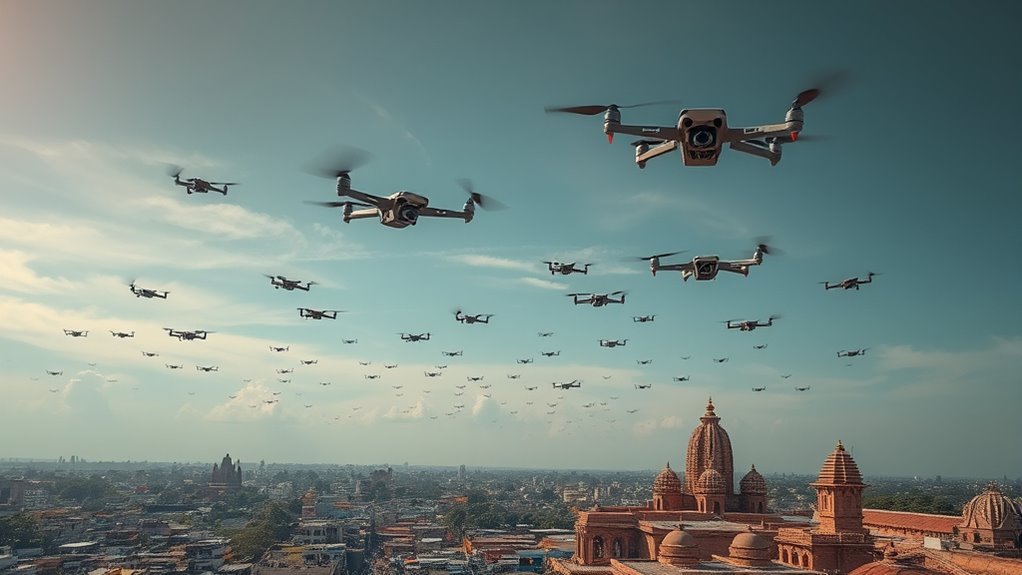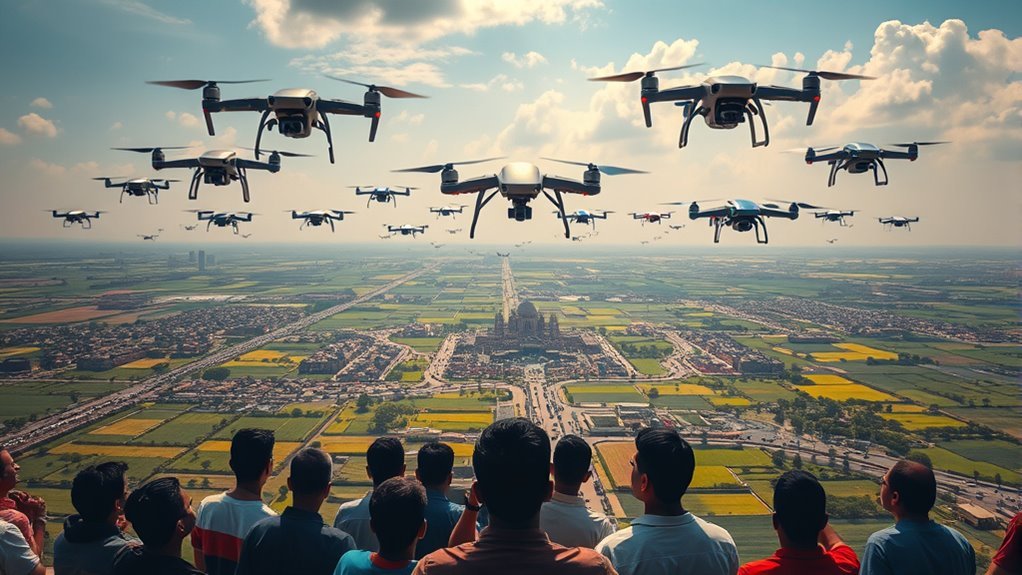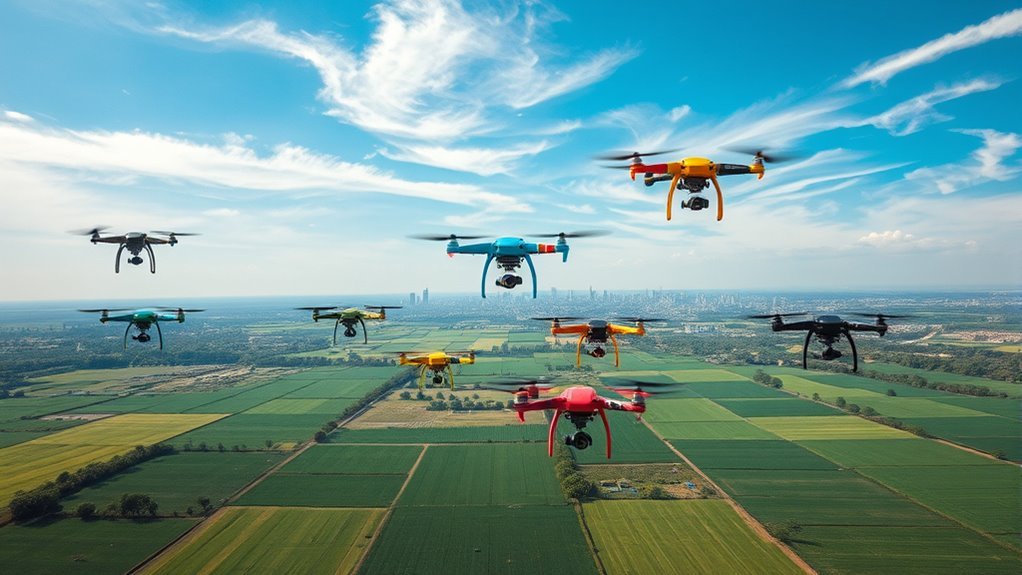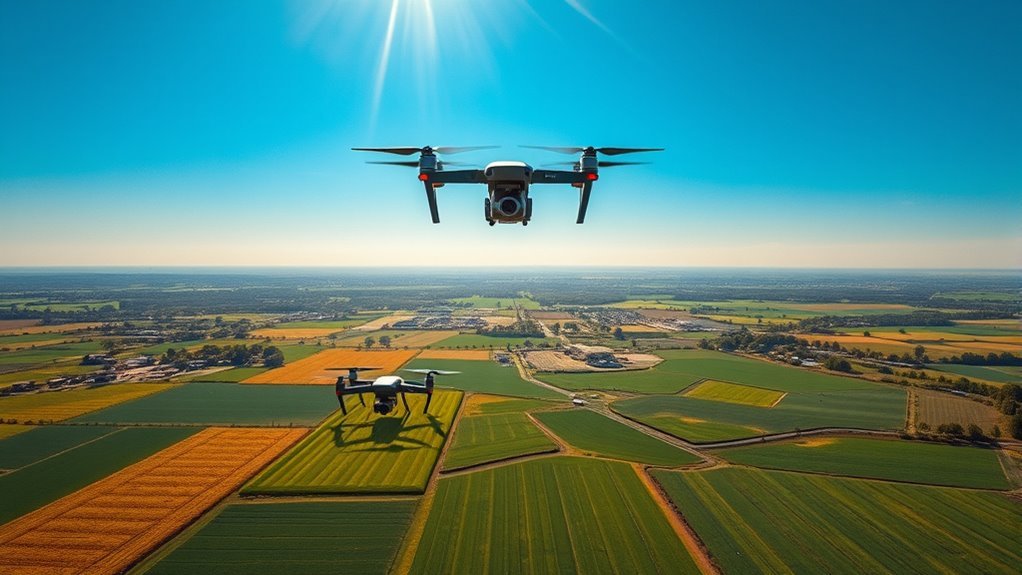As of October 2023, India has over 70,000 registered drones, showcasing a robust growth in its drone market. This includes a mix of commercial, civilian, and military applications. The increasing adoption of drones is driven by advancements in technology and integration across various sectors, such as agriculture, logistics, and surveillance. Regulatory frameworks are evolving to support this growth. Exploring these developments further can provide insights into the future trajectory of India’s drone industry.
Overview of India’s Drone Market

As the demand for advanced technology continues to rise, India’s drone market has emerged as a dynamic sector poised for significant growth. You’ll find that the applications of drones are vast, particularly in drone delivery and aerial photography. The shift toward e-commerce has accelerated the need for efficient delivery systems, with drones offering rapid, cost-effective solutions. Additionally, the use of aerial photography is transforming industries like agriculture and real estate, providing critical insights and enhancing decision-making processes. Regulatory frameworks are evolving, facilitating innovation while ensuring safety. As technology advances, the integration of artificial intelligence and automation will further bolster the sector’s expansion, heralding a future where drones are integral to everyday operations across various domains.
Current Statistics on Drone Numbers

As you consider the current statistics on drone numbers in India, it’s essential to look at the total registered drones and differentiate between military and civilian applications. Recent data indicates a significant increase in both sectors, reflecting the growing importance of unmanned aerial systems. Understanding these figures will provide insight into how drones are shaping various industries and defense strategies in the country.
Total Registered Drones
While the growth of drone technology has surged in recent years, the total number of registered drones in India provides a clearer picture of its adoption and regulation. Understanding the drone registration process is essential, as it guarantees compliance with government standards and promotes responsible usage. Currently, the registered drones in India encompass a variety of applications, particularly in aerial photography usage, which has gained immense popularity.
- Over 70,000 registered drones as of 2023
- Significant increase in commercial and recreational users
- Stringent regulations to guarantee safety and privacy
These statistics reflect a vibrant drone ecosystem in India, showcasing both the potential for innovation and the necessity for regulatory oversight. Your engagement in this evolving sector can help shape its future.
Military vs. Civilian Use
Although the distinction between military and civilian drone usage may seem clear-cut, the current statistics reveal a complex landscape in India. As of October 2023, the military operates around 1,000 drones primarily for surveillance and reconnaissance, emphasizing strategic military applications. Conversely, civilian drones number over 30,000, employed for agriculture, logistics, and disaster management, among other purposes.
Civilian regulations have evolved to accommodate this surge, ensuring safety and privacy while promoting innovation. However, the dual-use nature of some drones complicates regulatory enforcement, as technologies developed for civilian use often find military applications. Consequently, understanding the balance between military and civilian drone usage is essential for traversing India’s rapidly expanding drone ecosystem.
Key Sectors Utilizing Drones

Drones are transforming a variety of sectors in India, with agriculture, logistics, and surveillance leading the way. Their versatility is driving innovations that enhance efficiency and reduce costs.
- Agricultural applications: Drones help farmers monitor crop health, optimize irrigation, and manage pest control effectively. They also leverage advanced monitoring systems to detect crop threats in real time, empowering growers to make data-driven decisions. Additionally, drones utilize precision planting techniques to ensure optimal seed placement, further enhancing agricultural productivity.
- Delivery services: Companies are exploring drone technology to streamline last-mile delivery, making it faster and more efficient.
- Surveillance: Drones are employed for security and monitoring in urban areas, ensuring safety and better resource management.
Government Initiatives and Policies
The rapid adoption of drone technology in sectors like agriculture, logistics, and surveillance has prompted the Indian government to implement various initiatives and policies aimed at fostering growth in this field. These drone policies are designed to simplify the regulatory framework, encouraging innovation while addressing safety and privacy concerns. However, regulatory challenges remain significant, including the need for clear guidelines on airspace management and operational limits. The government is actively working to streamline licensing processes and promote research and development, making it easier for startups and established companies to enter the market. By balancing regulation with freedom for innovation, India aims to position itself as a leader in the global drone industry, releasing potential benefits across multiple sectors.
Major Players in the Indian Drone Industry
In examining the Indian drone industry, you’ll find a complex interplay of government initiatives, regulations, and a diverse range of market participants. Key private companies are shaping the landscape, while emerging startups are driving innovation and expanding applications. Understanding these major players is essential for evaluating the industry’s growth trajectory and potential.
Government Initiatives and Regulations
While advancements in drone technology have surged, government initiatives and regulations play an essential role in shaping the Indian drone industry. You’ll find that the Indian government has established a framework to guarantee drone safety and regulatory compliance. This involves various policies aimed at promoting innovation while maintaining safety standards.
- The Directorate General of Civil Aviation (DGCA) oversees drone regulations.
- The Government of India launched the Digital Sky platform for streamlined approvals.
- Initiatives like the Production-Linked Incentive (PLI) scheme incentivize local manufacturing.
These efforts not only facilitate industry growth but also address concerns regarding safety and compliance. By understanding these initiatives, you can appreciate the delicate balance between fostering innovation and guaranteeing responsible drone usage in India.
Leading Private Companies
Several key players are shaping the landscape of the Indian drone industry, each contributing unique innovations and services. Companies like DJI and Hindustan Aeronautics Limited (HAL) are at the forefront, focusing on drone manufacturing that meets various commercial and defense needs. Their advancements in technology have enabled improved aerial photography capabilities, making drones indispensable for industries such as agriculture, surveillance, and infrastructure development. Additionally, firms like IdeaForge and Terra Drone are also significant, specializing in bespoke solutions that cater to specific market demands. This competitive environment fosters innovation, enhancing the overall efficiency and effectiveness of drone applications in India. By understanding these major players, you can better appreciate the industry’s trajectory and its potential for future growth.
Emerging Startups and Innovations
The Indian drone industry is not just defined by established companies; a wave of emerging startups is driving innovation and expanding the market’s potential. These drone startups are focusing on innovative solutions that cater to various sectors, from agriculture to logistics.
- Agri-tech drones: These startups are developing drones equipped with sensors and imaging technology to optimize farming practices.
- Delivery drones: Companies are creating solutions for last-mile delivery, enhancing efficiency and reducing costs.
- Surveying and mapping: Startups are leveraging drones for accurate surveying, offering significant time and resource savings.
As you explore this dynamic landscape, you’ll find that these innovative solutions not only address current needs but also pave the way for future advancements in the drone industry.
Drone Technology Developments
As drone technology continues to evolve rapidly, India is witnessing significant advancements that enhance both civilian and military applications. You’ll find that domestic drone manufacturing has gained momentum, driven by government initiatives and private investments. This growth not only boosts local economies but also fosters innovation in design and functionality. Moreover, effective airspace management is becoming essential as drone operations increase. Advanced algorithms and software solutions are being developed to guarantee safe navigation and minimize collisions, allowing for a seamless integration of drones into the existing air traffic systems. These developments are setting the stage for a more robust drone ecosystem, promising to revolutionize industries like agriculture, logistics, and surveillance, while maintaining prioritization of safety and efficiency in operations. Additionally, innovations in AI-driven autonomous navigation will play a crucial role in enhancing the safety and reliability of drone operations. To support this integration, compliance with NDAA standards is critical for ensuring that drone technology does not compromise national security.
Challenges Facing Drone Adoption
While drone technology offers numerous benefits, various challenges hinder its widespread adoption in India. You’ll find that several factors complicate the landscape:
Challenges like regulatory hurdles and public perception hinder the widespread adoption of drone technology in India.
- Regulatory hurdles slow down the approval processes for drone operations. The complexity of advanced control algorithms further complicates regulatory compliance, requiring extensive testing before approval.
- Public perception often leans toward fear, driven by safety concerns and privacy regulations.
- Technological limitations restrict capabilities, making integration issues with existing infrastructure a significant barrier.
These challenges create a competitive market where companies struggle to innovate while adhering to strict guidelines. Infrastructure challenges, like inadequate landing zones and charging stations, further complicate the scenario. Addressing these issues is essential for releasing the full potential of drones, paving the way for safer, more efficient operations in various sectors. Moreover, strategic partnerships are crucial for navigating regulatory complexities and fostering innovation in the drone industry.
Future Trends in Drone Usage
As you consider the future of drone usage in India, you’ll notice a significant shift towards commercial applications driven by evolving technologies. Changes in the regulatory framework are likely to facilitate this growth, allowing for broader integration across various sectors. Additionally, advancements in drone technology will enhance capabilities, positioning drones as essential tools in industries ranging from agriculture to logistics. The integration of AI and autonomous systems will further optimize operational efficiency and decision-making processes. Asylon’s innovations in drone technology will enable these devices to adapt to various environments, ensuring reliable performance across diverse applications.
Commercial Drone Applications
With the rapid advancements in drone technology, the future of commercial applications is poised for significant transformation. You’ll likely see innovations in how businesses utilize drones for various functions, paving the way for enhanced efficiency and creativity.
- Drone delivery: Expect a surge in logistics companies adopting drones to streamline last-mile deliveries, reducing time and costs.
- Aerial photography: Industries like real estate and tourism will increasingly rely on drones for high-quality imagery, enhancing marketing strategies.
- Agricultural monitoring: Farmers will benefit from drones for crop surveillance, enabling precise data collection and improved yields.
These applications not only illustrate the versatility of drones but also highlight the potential for increased autonomy in commercial operations, fostering a new era of innovation.
Regulatory Framework Changes
Although the drone industry is rapidly evolving, the regulatory framework surrounding it is struggling to keep pace, leading to a pressing need for updates. As drone usage expands, regulatory compliance and safety standards must adapt to guarantee safe integration into the airspace.
| Aspect | Current Status |
|---|---|
| Regulatory Compliance | Lacks thorough guidelines |
| Safety Standards | Inconsistent across sectors |
| Operational Restrictions | Vary by region |
| Pilot Training | Limited standardization |
| Public Awareness | Needs improvement |
The future of drone regulations will likely focus on harmonizing these elements, promoting innovation while safeguarding public safety. It’s essential for stakeholders to advocate for a flexible framework that accommodates the dynamic nature of drone technology.
Technological Advancements Ahead
The regulatory challenges currently faced by the drone industry underscore the urgency for technological advancements that can enhance operational efficiency and safety. As you look ahead, consider how emerging trends in drone automation and aerial robotics could reshape the landscape:
- Enhanced navigation systems for improved route optimization.
- AI-driven analytics that enable real-time decision-making.
- Swarm technology allowing multiple drones to operate collaboratively.
These advancements are essential for addressing regulatory concerns while maximizing the potential of drone applications, from agriculture to disaster management. With a focus on safety and efficiency, the future of drone technology promises to foster greater autonomy and versatility, providing you with unprecedented opportunities to explore and innovate within this rapidly evolving field.
Impact of Drones on Agriculture
As agricultural practices evolve, drones are becoming a pivotal tool in modern farming, offering precision and efficiency that traditional methods lack. These unmanned aerial vehicles enhance precision agriculture by enabling real-time data collection and analysis. With advanced sensors, drones facilitate crop monitoring, allowing you to assess plant health, soil conditions, and irrigation needs more accurately than ever before. This data-driven approach minimizes resource wastage and maximizes yields, empowering farmers to make informed decisions. Additionally, drones can cover large areas quickly, reducing labor costs and time. As you consider integrating drones into your farming operations, remember their potential to revolutionize agricultural practices, ensuring sustainability and increased productivity while maintaining your freedom to innovate. Furthermore, Delair’s cameras provide high-resolution imaging for crop health monitoring, enabling early detection of crop stress and informing timely interventions. By leveraging real-time monitoring, farmers can identify crop issues early and implement targeted interventions, further enhancing overall farm efficiency.
Drones in Disaster Management and Surveillance
In addition to agricultural applications, drones have proven invaluable in disaster management and surveillance. Their ability to quickly gather data from hard-to-reach areas enhances disaster response efforts considerably. By utilizing aerial surveillance, authorities can assess damage, locate victims, and coordinate rescue operations more effectively.
- Drones provide real-time imagery, aiding in rapid decision-making. They achieve centimeter-level accuracy in mapping, which is crucial for effective damage assessment.
- They can transport essential supplies to isolated regions during crises.
- Aerial data helps in mapping affected areas for planning recovery.
- Drones enhance emergency response logistics by swiftly delivering medical supplies to remote areas, ensuring that help reaches those in need without unnecessary delays.
As you can see, the integration of drones in these fields is reshaping how we handle emergencies. Their technological capabilities not only streamline operations but also guarantee that help reaches those in need swiftly and efficiently, embodying the essence of freedom in disaster response.
Frequently Asked Questions
What Are the Regulations for Flying Drones in India?
You need to understand that in India, drone regulations require insurance for commercial use, and operational limits restrict altitude and no-fly zones. Compliance is essential for safe and legal drone operations, ensuring your freedom isn’t compromised.
How Are Drones Registered in India?
Imagine soaring through the skies with your drone, but first, you need to complete the drone registration process. It’s an online process that’s streamlined, ensuring you can fly freely while adhering to regulations.
What Is the Cost of Purchasing a Drone in India?
The cost of purchasing a drone in India varies considerably depending on drone types and brands. Entry-level models can start around INR 15,000, while advanced commercial drones may exceed INR 1 lakh, reflecting diverse market options.
Are There Any Drone Pilot Certification Requirements in India?
In India, you’ll need to complete drone training and obtain a pilot license to operate drones commercially. This guarantees safety and compliance with regulations, granting you the freedom to fly within legal boundaries.
What Are the Privacy Concerns Related to Drone Usage in India?
You should consider the privacy concerns surrounding drone usage in India, particularly regarding surveillance implications and data protection. These technologies can intrude on personal privacy, raising significant ethical questions about individual freedoms and governmental oversight.

